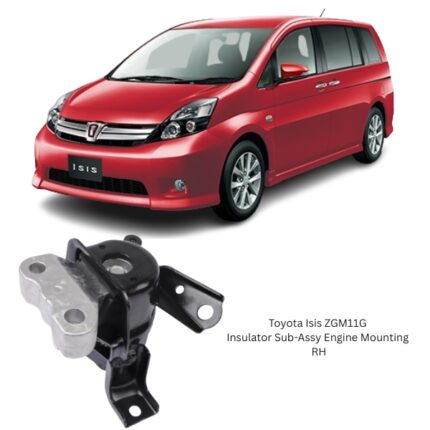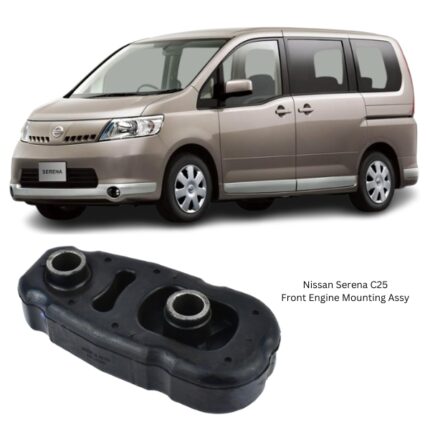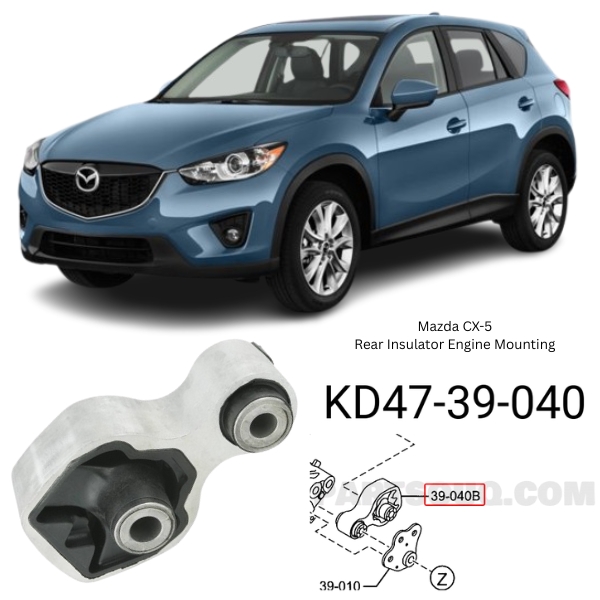Get Mazda CX-5 Rear Insulator Engine Mounting KD47-39-040 in Kenya
The Rear Insulator Engine Mounting is a vital structural and vibration-damping component of a vehicle’s engine support system. Strategically located at the rear section of the engine or transmission assembly, it plays a crucial role in securing the powertrain to the chassis while also absorbing and isolating vibrations and torque-related forces that occur during normal driving conditions.
This component ensures the proper alignment and positioning of the engine and transmission, contributes to reduced noise and vibration within the cabin, and helps prevent mechanical stress and premature wear on connected systems. As automotive technology has evolved to focus on performance and driver comfort, the rear engine mount has become more refined, often incorporating hydraulic or active damping technology to meet the demands of modern vehicles.
Primary Purpose and Function
The rear insulator engine mount serves as both a support structure and a vibration isolator. As the engine runs, it generates dynamic forces in multiple directions—vertical, horizontal, and torsional. The rear mount controls movement that the front and side mounts cannot absorb alone, particularly longitudinal (front-to-back) motion that results from acceleration, braking, and gear changes.
Core functions include:
-
Engine Support: Helps bear the weight of the engine and transmission assembly.
-
Torque Control: Resists engine rotation under high torque load, especially during rapid acceleration or deceleration.
-
Vibration Isolation: Damps out engine-generated vibrations before they reach the chassis or passenger cabin.
-
Engine Positioning: Maintains optimal engine alignment with drivetrain components, ensuring efficient power delivery and system coordination.
-
Protection of Adjacent Parts: Minimizes strain on connected systems such as the exhaust manifold, driveshafts, sensors, and electrical harnesses.
The rear mount works in tandem with other engine mounts to create a balanced, secure, and vibration-free mounting system.
Design and Materials
The Rear Insulator Engine Mounting is a composite part made from a combination of metal, elastomer, and sometimes fluid-filled damping materials, all designed to endure high stress, heat, and exposure to harsh underhood conditions.
Key Components:
-
Mount Bracket
Typically made from forged steel or cast aluminum, this bracket is bolted to either the transmission housing or chassis subframe. It provides the mechanical support needed to anchor the mount securely. -
Elastomeric Core (Rubber or Polyurethane)
The insulator portion is a bonded rubber element designed to flex and absorb vibration. It is tuned for specific stiffness and damping characteristics. -
Inner Sleeve or Bushing
This cylindrical insert houses the mounting bolt and helps distribute load evenly across the mount. -
Hydraulic Chamber (in advanced designs)
Some mounts feature a sealed chamber filled with a special fluid that offers additional damping, especially for low-frequency vibrations experienced at idle. -
Heat Shield (optional)
A metallic shield may be present to protect the rubber portion from high temperatures generated by the exhaust or engine block.
These materials are engineered for long-term durability and optimized to withstand continuous flexing, pressure, and environmental exposure.
Performance and Characteristics
A properly functioning rear engine mount provides:
-
Smooth Engine Operation: Prevents harsh movement or jolting under load changes.
-
Effective NVH Control: Reduces noise, vibration, and harshness felt inside the vehicle.
-
Stability Under Load: Maintains engine and transmission alignment during acceleration, braking, and gear shifts.
-
Thermal and Chemical Resistance: Withstands exposure to heat, engine oil, transmission fluid, and road debris.
-
Fatigue Resistance: Maintains shape and damping performance over thousands of operational cycles.
These performance characteristics ensure a smooth, responsive driving experience and protect the structural integrity of the powertrain.
Signs of Wear or Failure
The rear insulator engine mount is subject to degradation over time due to temperature cycles, load stress, and material fatigue. When worn or damaged, it can lead to various symptoms:
-
Clunking or Knocking Sounds
Metal-to-metal contact may occur if the rubber isolator deteriorates or collapses, resulting in audible noise during gear shifts, acceleration, or over bumps. -
Excessive Vibration
A failed mount can no longer isolate engine vibrations, resulting in increased cabin vibration—especially at idle or during load changes. -
Engine Misalignment
Engine sagging or tilting due to a worn rear mount can cause driveline angles to shift, affecting axle geometry and transmission operation. -
Gear Shifting Difficulty
Excessive engine movement can disrupt the smooth engagement of gears or result in noticeable shifting delays. -
Visible Cracks or Leaks
A cracked rubber bushing or leaking hydraulic fluid (in fluid-filled designs) indicates a need for immediate replacement. -
Engine Rocking
Engine movement during start-up or shutdown becomes more pronounced, sometimes visibly shaking in the bay.
Ignoring these symptoms can lead to further damage to exhaust components, driveshafts, and surrounding engine hardware.
Installation Overview
Installing a new Rear Insulator Engine Mounting typically involves lifting or supporting the engine or transmission and replacing the existing mount with care. While the process varies by vehicle, the general steps include:
-
Safety Precautions
Park the vehicle on level ground, engage the parking brake, and disconnect the battery. -
Support the Engine/Transmission
Use a hydraulic jack with a wood block, or an engine hoist, to relieve stress from the mount. -
Remove Obstructing Components
This may include underbody panels, exhaust brackets, or crossmembers. -
Unbolt the Mount
Loosen and remove the bolts securing the mount to the engine and chassis. -
Inspect Surrounding Mounts
Check other mounts for signs of wear, as replacing one worn mount may shift additional stress onto others. -
Install the New Mount
Position the new mount correctly, torque all bolts to manufacturer specifications, and ensure proper alignment. -
Reassemble and Test
Replace any removed components and test the vehicle for vibration and noise. A short drive can confirm successful installation.
Maintenance Tips
Although the rear engine mount is largely maintenance-free, routine inspections during oil changes or major services can help detect early signs of failure.
Things to check:
-
Deterioration or hardening of the rubber
-
Cracks, splits, or tears in the elastomer
-
Missing or loose bolts
-
Fluid leaks from hydraulic chambers
Early detection and replacement can prevent related component failures and costly repairs.
Benefits of Replacing a Worn Rear Mount
-
Improved Cabin Comfort: Reduces vibrations and improves the smoothness of the driving experience.
-
Protects Powertrain Components: Maintains proper alignment, reducing stress on axles, exhaust, and wiring.
-
Restores Handling Precision: Eliminates engine rocking that affects balance and cornering.
-
Prevents Further Wear: Stops abnormal wear on transmission mounts, bushings, and drivetrain components.
-
Reduces Noise and Impact: Eliminates knocking sounds during gear changes or road impacts.
Follow us on Facebook for more parts.





Reviews
Clear filtersThere are no reviews yet.